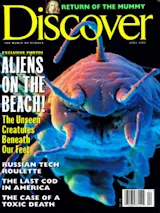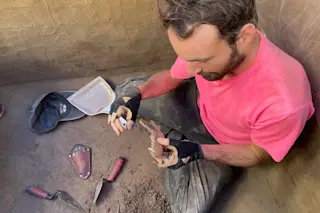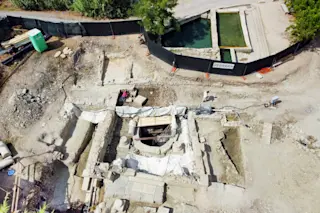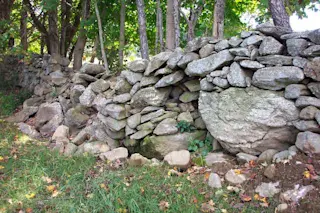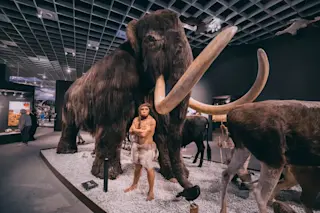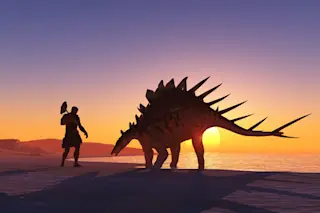Three millennia ago in the hot, dry land of Thebes, there lived a woman named Djedmaatesankh. Djedmaatesankh was neither princess nor priestess but an ordinary middle-class Egyptian. When she died, in the middle of the ninth century B.C., her husband, Paankhntof, had her mummified and encased in a cartonnage--a shell-like coffin of linen and glue--as was fashionable for a woman of her station. The cartonnage was decorated with pictures of gods and protective entities and with Djedmaatesankh’s image in gold. She was probably buried along the west bank of the Nile, across a ridge from the Valley of the Kings.
Djedmaatesankh eventually resurfaced at the Royal Ontario Museum in Toronto. Egyptologists there have no record of exactly when or how she arrived, except that it was around the beginning of this century. They do know that her cartonnage is one of the best preserved of its period.
Much of what they know of Djedmaatesankh’s life they’ve learned from the inscriptions on that sealed coffin; the mummified body within remains unseen and untouched. For a museum wanting to show Egyptian art, the decorations are the most important thing, says curator N. B. Millet. And the cartonnage is, after all, just a shell. If we had gotten the lady out, we probably would have busted it up pretty badly. It just wasn’t worth it.
There is more to know about Djedmaatesankh than can be read on the cartonnage, of course. Last year some of her secrets were revealed, thanks to Peter Lewin, a pediatrician at the Hospital for Sick Children in Toronto and a leading researcher in the field of paleopathology, the study of disease and injury as evidenced in bones and fossils. Using a CT scanner and a computer system that can turn the scans into three-dimensional pictures, Lewin’s team was able to unwrap the mummy, if only on a computer screen. Without disturbing Djedmaatesankh’s precious shell, Lewin’s team peeled away layer after layer, revealing first the structure of the cartonnage, then the linens in which the mummy was wrapped, then Djedmaatesankh’s skin and bones, and finally the embalmed and packaged internal organs. They also learned what most likely killed her.
CT scanning produces cross-sectional X-rays of the body, like the slices in a loaf of bread. The technology has been used in the study of mummies since 1977, when Lewin and his partner, Derek Harwood-Nash, scanned the brain of Nakht, a 14-year-old Egyptian weaver who died 3,000 years ago. Djedmaatesankh herself, in fact, is no stranger to CT scans: Lewin performed a full body scan on her in 1978. The technology was still in its infancy then, and the images didn’t provide much information. We did it to show that it was possible, Lewin says. But CT scanners--and the computers and software that process the images--have advanced quite a bit since the late 1970s. That’s why Djedmaatesankh was brought in for another scan.
This time Lewin’s team produced nearly 300 images. With regular patients, especially with kids, you’d have to worry about radiation dosage, says Stephanie Holowka, the ct technician who worked on the scans. But Djedmaatesankh is, after all, dead. So we did thinner slices on her, for more detail.
Like normal X-rays, CT-scan images measure the densities of different parts of the body--bone, skin, blood, and other organs--and depict them in shades from white to black. Bone, for example, is very dense and appears almost white. Fat and skin are less dense and show up as shades of gray, while a liquid like cerebrospinal fluid appears black.
To visualize a particular tissue--say, the bone in a scan of the head--the computer enhances only the objects in a slice that fall within the normal density range for that substance. Then the edited slices are stacked on top of one another to produce a 3-D image. Onto that three- dimensional skull the computer can superpose other elements with different densities, creating a cutaway.
Editing the slices of Djedmaatesankh was time-consuming, since the distinctions between tissues had blurred. With the mummy, you are dealing with tissues that have lost their water and become a lot harder-- more mineralized--and so more dense, says Holowka. The bones, however, have lost minerals over time and become softer. So everything has kind of the same density.
When Holowka electronically peeled away the linen and skin on the torso, she found that Djedmaatesankh had probably never had children. When a woman bears a child, the pubic bone is separated from the pelvis from the force of the infant coming through, Lewin explains. But we found that her pubic bone was perfectly intact. Most married Egyptian women of her age-- judging by the fusion of her bones and the wear on her teeth, she was 30 to 35 years old--would have had several children. So perhaps she was infertile, Lewin says.
Lewin was in for a bigger surprise when he looked at her face. The first thing we noticed when we peeled away the skin was a swelling of her left upper jaw, Lewin says. A 3-D image inside her skull revealed more. She had this horrendous, painful-looking dental abscess, caused by a diseased upper left incisor.
The abscess was an inch in diameter and had probably been there for at least several weeks before she died. The bone on the surface of the upper left jaw was pitted with small holes, indicating that it was also infected. So not only was there a lot of pus, and bone being eaten away, but she was also getting a reaction on the front of her jaw, Lewin says. She probably had pus underneath the skin of her cheek.
A routine course of antibiotics would have stopped the abscess in its tracks. But in Djedmaatesankh’s day a patient could only turn to rudimentary dentistry. High-resolution scans show tracks on the jawbone that may indicate an unsuccessful attempt to drain the abscess. I am quite convinced that the infection was a major cause of her death, Lewin says. This was a very active infection, basically a boil within a bone. Eventually, Lewin guesses, it burst, spreading infection throughout Djedmaatesankh’s body. She probably got blood poisoning and died.
Lewin hopes that one day the level of detail of CT scanning will allow noninvasive postmortems to be performed on people whose religious beliefs prohibit autopsies. In the meantime Egyptologists have a new window onto their mummified collections. We’re delighted that we now have a technique for examining these cartonnages, says Millet. We feel much better informed about our lady than we did before. And we learned just as much, I’m sure, from the CT scan as we would have from somehow getting her out of the thing.


